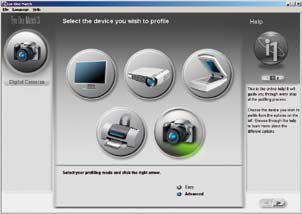articles/Digital/gretagmacbetheye-page1
GretagMacbeth Eye 1 XT - part 1 of 1 2 3 4
by Mike McNamee Published 01/09/2005

All the software from the Eye 1 product is wizard driven and simple to use.
As part of the discussion of quality we wanted to look at colour accuracy in reproduction in all its aspects. We recently reviewed the X‑Rite Pulse system and here we make a direct comparison between this and the GretagMacbeth Eye 1 XT system.
GretagMacbeth were one of the first of the major industry players to launch a profiling solution aimed at individual professional and enthusiast photographers.
The software has undergone gradual changes since launch and, in the main, become more affordable. Eye 1 came from a heritage of devices costing up to £10,000 so the reduction is considerable, fuelled by increased take-up at the lower price point. There is an argument to say that once you embark on the colour management route you might as well go the whole hog, so we look at the comprehensive XT package which includes tools for measuring, lighting, scanning, cameras, prints monitors and projectors (see the labelled picture of the carrying case).
Printer Calibration This is one of the more important features and so it is where we start. The ability to profile your printed output at high accuracy will be a boon that you will not then forgo readily!
Eye 1 match provides three targets:
TC9.18 RGB i1 - 918 patches
i1 RGB 1.5 - 288 patches
i1 Easy - 45 patches

The XT comes in its own protective carry case, the lid flap housing the software and targets.
It does not include the ability to profile CMYK, the type required for printing presses, inkjets are RGB devices as far as profiling is concerned. The profiling process is quite simple and wizard driven throughout. You select your target, select your printing conditions (eg printer model, resolution, media type), print the target, let it dry (overnight for dye ink, about 20 minutes for pigment ink), then measure it. Target measurement is accomplished by slowly dragging the spectrophotometer over the rows of coloured patches whilst it is attached to your computer. If you make a mistake by missing a row, going too fast or measuring the wrong row, the program tells you and asks you to try again. The larger the number of patches, the longer this process takes. We chose to use the high resolution 928 patch target and it took 6m20s to measure, including about nine misreads. Unless you have to make dozens of profiles it is hardly worth the bother using the lower resolution target, we would only use a 45 patch target for very rough work. In a separate trial we found no improvement using several thousand patches compared with 700-800; other claims are made but trebling the number gets a little tedious for a very marginal refinement in profile quality. We hit a slight snag with the design of the measuring cradle of the Eye 1; once you have progressed a certain way, the feet of the spectro start to scratch the rows you have already measured. This is not a problem for a single measurement but if you wish to aggregate readings or simply have another go, the target is damaged and thus suspect. The Pulse is a better design in this respect, it protects the print. Patch measurement on the Pulse took 5m9s with only one repeat needed. The Eye 1 has to be attached to the computer via its USB cable as it also acts as a program dongle. This is a bit of a pain as you have to have the delicate spectro cluttering up your desk all the time if you want to use the program for any reason. The high-end systems have always been dongled - both RIP makers and profile building suppliers have always been paranoid about software piracy, festooning their devices in a variety of dongles, my USB hub looks like a hi-tech porcupine!
You are currently on page 1
- GretagMacbeth Eye 1 XT page 1
- GretagMacbeth Eye 1 XT page 2
- GretagMacbeth Eye 1 XT page 3
- GretagMacbeth Eye 1 XT page 4
1st Published 01/09/2005
last update 09/12/2022 14:54:50
More Digital Articles
There are 0 days to get ready for The Society of Photographers Convention and Trade Show at The Novotel London West, Hammersmith ...
which starts on Wednesday 15th January 2025





